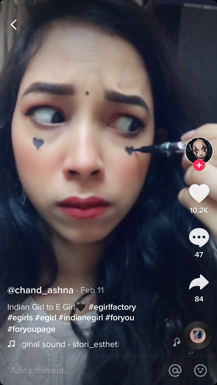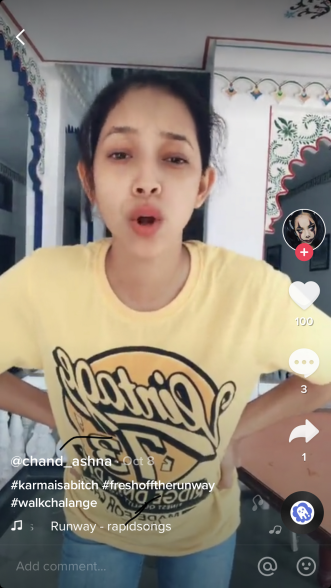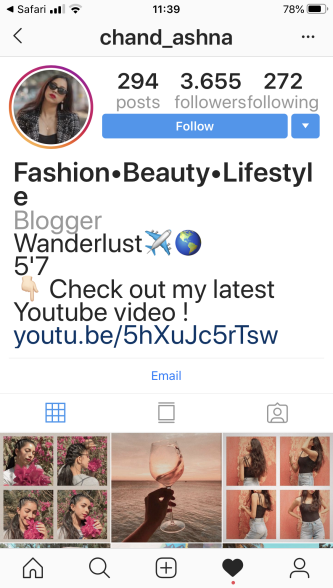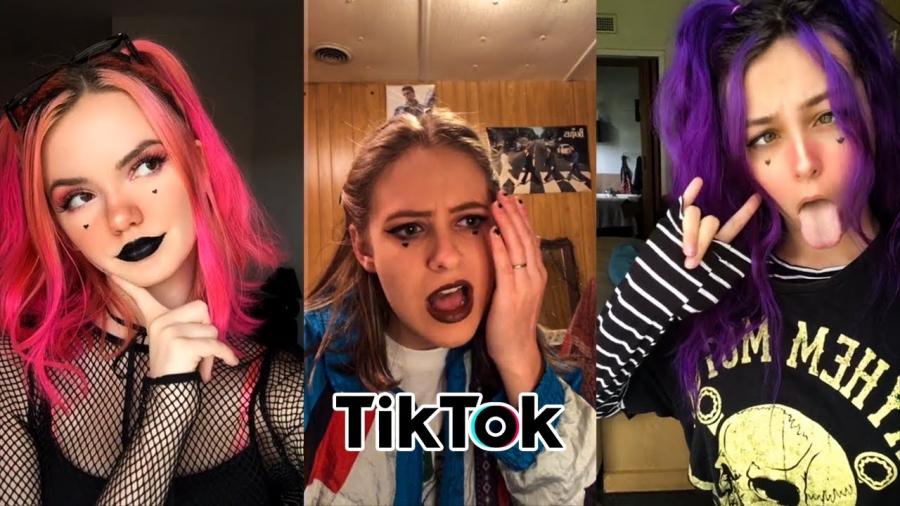
How to become an e-girl on TikTok
TikTok is a social media video app designed for creating and sharing short lip-sync, comedy, and talent videos. It allows users to make videos ranging from 15 to 60 seconds in length, which play host to memes, trends, and challenges. TikTok features a massive following from the younger generations, who yearn for personal branding and self-identification. For them, TikTok is a place for creativity, for playing cool and getting likes.
An interesting subculture that has emerged on TikTok is that of "e-girls". E-girls are "cool" young people presenting their image, often from their homes, sporting 90’s style make-up, hairstyles, and attire. E-girls on TikTok share an iconic look: bold black eyeliner with wings; little shapes such as a cross, a heart or dots under the eyes; blush on their cheeks and nose; septum piercings; clear gloss or dark matte lipstick; half-pigtails with small hair clips and two different hair colors. They often wear oversized t-shirts or crop tops and A-line skirts or belted high-waist pants.
Figure 1. TikTok e-girls
Yet, the term "e-girl" did not start on TikTok. The earliest definition for the term on Urban Dictionary describes e-girls as "internet sluts". They are a group who lures gamer boys through their good looks, flirting with them to gain attention; so, the original meaning of "e-girl" is negatively charged. Still, young girls on TikTok are starting this hot trend of presenting themselves as e-girls despite those negative connotations. Obviously, the meaning of the term has undergone changes. Besides, the online community has spin-offs in the offline world, such as shops that offer the "right" type of clothes, e-girls attending music festivals, but also getting unwanted attention from older men.
An online observation of e-girl posts reveals current connotations of the term, personal branding and identity construction around the phenomenon. Three major types of e-girl posts were found: transformation, self-identification and elderly ‘e-girl’ posts.
The creators’ self-identification is displayed in different ways, such as through dressing codes, texts they use to describe their posts, and comments they use to reply to the viewers.
The first type - transformation - indicates how creators transform from a girl sporting a casual style to an e-girl. This is done either by showing the change in a so-called "e-girl factory", or by drinking something labeled "e-girl juice". Other posts show the reversed process.
In the second style of videos focusing on self-identification, different subcategories can be distinguished: national identity emphasis (where creators emphasize their national identity when presenting themselves as an e-girl; e.g. by wearing t-shirts with their national language printed on them); e-girl identity ambiguity (where creators do not know what an e-girl is but simply follow the trend by asking questions like "Am I an e-girl yet?"); e-girl identity confirmation (where creators know very well what being an e-girl means and confidently present their e-girl identity by stating "Never felt more myself"); and identification of other categories of "online girls" (here, creators compare different type of online girls such as VSCO girls and Tumblr girls). The creators’ self-identification is displayed in different ways, such as through dressing codes, texts they use to describe their posts, and comments they use to reply to viewers.
The third pattern of posts found is that of elderly e-girl posts. Grandmas are dressed up like e-girls by their granddaughters and dance like e-girls, or in other cases, elderly women themselves follow the e-girl trend posting videos on TikTok though they don’t follow too much of the e-girl look and dressing codes. They present themselves as e-girls by following the same music and mimicking e-girl dance moves.
The most salient post found was that of an Indian girl transforming into an e-girl, because it showed that it is probably too easy to assume that girls who present themselves as e-girls want to be identified as a member of the e-girl community. Even though the Indian girl changed into an e-girl, it seems that at the same time her national identity was showing in a distinct, layered way.
#indianegirl
The text of the post reads "Indian Girl to E Girl", indicating a transformation, followed by an emoji of a black heart. Accompanying hashtags show two identities: #egirl and #indianegirl. While #egirl stands for the end result of the transformation, #indianegirl is an interesting mix: the Indian identity is still in there. It gives the impression of a superimposed layer. However, when checking this hashtag on TikTok, we find that there are only two other such posts, one by the same girl and one by another Indian girl, which was posted later. Therefore, it can be concluded that this is not a trending topic and that "our" Indian girl has made this label up as she feels it is important to show her followers that underneath the new identity is still her old self.

Figure 2. "Indian Girl to E Girl"
The start of the video shows her applying e-girl-style makeup while looking anxious. Is she scared of the transformation? She is shown with a black dot between her eyebrows. Much like the hashtags, this identifies her instantly as an Indian girl. In most other posts that were observed, there is no such distinct reference to national identity. This black dot is called a "bindi" (Forehead markings, 2019). Hindus often believe in the third eye, located between the eyes, with which one can see spiritual truths. It can be worn for religious reasons, but women also often wear it to show they are married (red color) or unmarried (black color) or even because nowadays it is trendy. As no other reference is made to religion, it is assumed that this girl uses the bindi for the latter reason. The fact that in the post the bindi is removed, signifies a thorough transformation: she wants to show that she embraces the concept of e-girl wholeheartedly: she is even prepared to wipe out (literally) the traditional identifier.
Online presence
Analyzing earlier TikTok posts by the same user gives the impression that she wants to show that being an e-girl is just one of the identities that she is able to assume. Her profile picture shows her face with Halloween makeup on, yet her name shows her Indian roots: Ashna Chand. In various other videos she also shows a transformation, changing into another look. There are several Halloween makeup videos, always showing a before and after look. In another post (see Figure 3), she is seen standing in a very distinct Indian interior with traditionally painted doorways. She is wearing Western clothes (jeans and a t-shirt) and her hair is tied in a ponytail, looking girly; then, suddenly, she is standing outside, dressed in a long flowing skirt, a singlet, and high heels, with chandelier earrings, long loose hair and a bindi. She is whirling around and posing as a model, in a more grown-up style. Importantly, a mixture of Western and Indian components is shown in both parts of the transformation. In yet another video, she is seen walking in the street dressed in black, strutting like a model. There is no link to the Indian identity, but the soundtrack is traditional Indian music. It seems that she wants to show her followers that she is capable of switching back and forth between different identities while her roots (being from India) are always showing.

Figure 3. Transformation
Looking at her Instagram account, her profile picture shows her wearing sunglasses, red lipstick and a Western-style jacket, and her bio features the words "blogger", "fashion", "beauty" and "lifestyle" accompanied by an airplane and a globe emoji. This gives a much worldlier, internationally-oriented impression. However, looking at some of the photos posted, we see that she always tags a location: Bombay, Goa, Delhi, Mumbai, all cities in India. The hashtags often show an Indian element as well: e.g. #indianmodeling, #delhiinfluencer. She points followers to her Youtube video, which shows her shopping and modeling clothes in a market in Delhi. This confirms that, underneath the worldly appearance, her core identity is once again constructed as Indian in her posts.

Figure 4. @chand_ashna's Instagram account
Comments
In the comments section many followers (both male and female) enquire about the meaning of "e-girl", confusing it with other categories such as those of emo or edgy girls, as they apparently aren't familiar with the concept. They urge one another to look up the meaning on Google. One person asks the creator directly: “Are you an egirl??!!please answer”, to which she responds: “Hell no”, followed by a laughing/crying emoji. This indicates that she does not actually identifyas belonging to the community of e-girls. The fact that she answers the question shows that she finds it important to make this clear. Another person states: “you’re late sis”, to which the creator replies: “I knoe” (original spelling), followed by the same emoji. This could mean the commenter thinks she is late in following this trend of transforming into an e-girl, suggesting that it is already a bit outdated.
The users who post e-girl videos sometimes assume multiple or layered identities in one post and it cannot be assumed that they want to be e-girls themselves.
Another user states that the video is similar to content by Nagma (i.e. Nagma Mirajkar) a so-called "popular creator" on TikTok with a very large following of 11.2 million users. She is a popular Indian star and social media influencer. The commenter asks who agrees with them, but there are no replies. However, bring associated with an important influencer is likely welcomed by the creator in question as she presents herself as an influencer as well. Yet, someone else indicates that she liked the Indian girl look better, acknowledging both identities. Some commenters feel that she “nailed” it, meaning she looks authentic.
Being an e-girl
It can be concluded that, for this particular creator, identifying as an e-girl is probably not so much about showing she is part of this community of e-girls, but rather that she has the skills to assume different personas and showcase them in an authentic way. Underneath these assumed identities is her core identity, namely that of an Indian girl, which is a very fundamental part of who she is, as seen in her posts. This core identity is always showing in subtle or more obvious ways.
In the end, a more general conclusion can be made about TikTok e-girls judging from this case study. The users who post e-girl videos sometimes assume multiple or layered identities in one post and it cannot be assumed that they want to be e-girls themselves, but only that they can present themselves as such - having the ability to transform into someone else, assume a different identity and look authentic.
